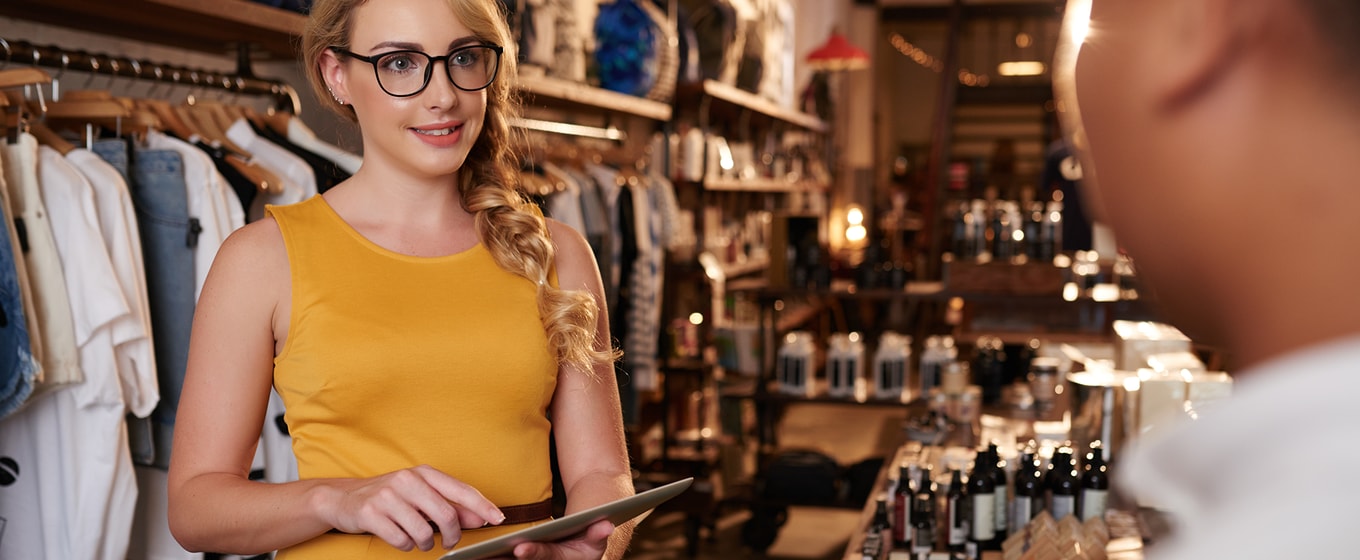July is Independent Retailer Month – the perfect time to celebrate the small businesses that shape our high streets.
In 2025, one big change for many shops is happening online: omnichannel retail. But what is it, and why should small business owners care?
What does “omnichannel” actually mean?
"Omnichannel" means "all channels." In retail, it means offering a seamless shopping experience across every way a customer shops. Whether someone is browsing on their phone, clicking through an email, or walking into a physical store, everything should feel connected. This is what creates a true omnichannel customer experience.
This differs from multichannel retail. Multichannel means you sell in different places, but they don’t always work together.
Omnichannel brings those touchpoints together, helping create a smoother experience for customers and saving time for business owners by keeping systems aligned, like syncing your website with your in-store till or CRM. Omnichannel means those places are linked. Stock levels match. Branding is the same. Customers can move between online and in-store without restarting the process. For small businesses, this integration helps unify the customer experience and improve user experience across all touchpoints.
What is omnichannel retailing?
Omnichannel retailing is a way of selling that connects online and offline shops. For example, a customer might:
- See a product on Instagram
- Check reviews on your website
- Buy online and collect it in-store
- Return it in person or by post
The journey feels easy for the shopper. That’s the goal of a good omnichannel strategy. The entire buying experience is seamless and personalised, offering customers convenience and choice across their preferred channels.
An effective omnichannel retail strategy helps unify customer touchpoints into a single, connected journey. It bridges the gap between physical stores and digital platforms, creating store experiences that reflect the same care, branding, and ease, whether customers are online or in-store.
Omnichannel vs multichannel: what's the difference?
Multichannel | Omnichannel | |
Customer experience | Different in each channel | Seamless across all channels |
Systems | Work separately | Linked together |
Example | Website + shop | Click-and-collect + shared rewards |
In short: multichannel gives customers choices. Omnichannel connects those choices into one smooth journey.
Multichannel might mean your online store and your brick-and-mortar store both exist, but customers have to start from scratch each time they visit. Omnichannel ensures those systems are aligned, giving your customers a seamless shopping experience whether they’re clicking or walking.
What does an omnichannel strategy look like?
A good omnichannel strategy includes:
- Integrated systems: Your website, till system, inventory, and emails all share data.
- Consistent branding: Same logos, tone of voice, and customer service.
- Real-time updates: Let customers know what's in stock and where.
- Flexible delivery: Offer home delivery, in-store collection, and simple returns.
For example, if someone buys a dress online and decides they need a different size, they can easily exchange it at the physical store. If stock levels are updated in real time, there’s no risk of over-selling or customer disappointment.
This seamless integration ensures the customer journey feels natural. It also empowers staff to better support customers with up-to-date information.
Small businesses can start small. Connecting your stock between your website and store is a great first step. Tools like Shopify POS can help sync online and in-store inventory, giving you a simple and effective starting point. Even using low-cost tools or POS systems that sync across platforms can make a big difference.
Explore affordable tools for UK businesses →
Creating a seamless omnichannel experience
A seamless omnichannel experience means everything works well together. Here's how to build one:
- Mobile-first website: Many shoppers start on their phones. Make sure your site loads quickly and is easy to navigate.
- Personalised messages: Use emails or push notifications based on customer behaviour. Send birthday discounts or reminders about abandoned baskets.
- Loyalty across all channels: Let people earn and use rewards whether they shop online or in-store.
- Flexible returns: Allow people to return items however they choose – online or in person.
- One example: A shopper sees a product in a physical store. They later get a reminder email and buy it online. A smooth journey like this builds trust.
Tools like Mailchimp or Klaviyo can help personalise communication channels. Meanwhile, Shopify offers an omnichannel approach that unifies your sales and customer data.
Why omnichannel matters for independent retailers
Omnichannel retailing isn’t just for big brands. It helps SMEs:
- Connect with customers across more platforms
- Offer better service and more choice
- Stand out from large chains by offering personal service
- Increase loyalty with a seamless experience across all touchpoints
For many customers, the line between online and offline shopping is already blurred. They expect to find your business online, check reviews, and browse products before deciding to visit your physical store. By offering a consistent experience, you’re more likely to turn interest into action.
For example, UK retailer Zara’s flagship at Birmingham’s Bullring and Grand Central shopping centre features automated collection and return points, while IKEA has expanded its click-and-collect network to accommodate its growing online business.
Read how to improve your customer experience →
Omnichannel retail trends in 2025
Here are some current omnichannel retail trends to watch:
- Social commerce: Selling directly through platforms like Instagram, TikTok, or Facebook Shops
- In-store tech: QR codes, mobile payments, and smart mirrors that recommend sizes
- Smart personalisation: Using customer data to offer tailored deals and product suggestions
- AI-driven chat: Chatbots that answer questions in real time across platforms
- Live shopping events: Live streams on social media where viewers can buy instantly
- Click-and-collect lockers: A secure way for customers to pick up their online orders 24/7
Even simple steps like adding online booking for in-store visits can boost your omnichannel approach. For instance, tools like Calendly allow customers to schedule appointments easily, helping you manage footfall and enhance convenience. These small changes help you meet your target audience where they are.
Getting started: tips for small retailers
Here’s how independent retailers can get started with omnichannel marketing strategies:
- Map your customer journey – How do customers find you? Where do they drop off?
- Sync your inventory – Link your online and in-store stock so it’s always up to date.
- Use email tools – Send newsletters, abandoned basket emails, and order updates.
- Integrate customer data – Learn from shopping behaviour to offer personalised service.
- Reward loyalty – Offer customers points or discounts for shopping in multiple ways.
- Stay consistent – Make sure your store signage, website, and social media all look and feel the same.
- Train your team – Everyone should understand how systems connect and how to help customers across channels.
These steps don’t have to be expensive or time-consuming. Many platforms offer free trials and affordable entry points.
Let’s grow
If you're ready to grow your store online and in person, consider upgrading your systems. At Fleximize, we help UK retailers with funding to improve websites, tech, and more. Whether you’re investing in your first e-commerce platform or upgrading your in-store tech, we can help.
Learn more about retail business loans →
Your common questions answered
It's when all your sales channels – online, in-store, mobile – work together to offer a smooth, connected experience.
It helps small businesses meet customer expectations, build loyalty, and offer better service.
Yes. Multichannel gives people more ways to buy, but omnichannel connects those ways into one strong journey.
Start small – sync your stock, set up an email system, and make sure your branding matches everywhere.
Click-and-collect, loyalty points used across platforms, personalised product suggestions, or push notifications based on customer actions.
No. Many platforms offer free or affordable options that grow with your business. You can find simple tools that help with seamless integration and communication channels.
Yes. A seamless omnichannel experience isn’t about size – it’s about connecting with customers in ways that matter. Even one location can benefit from linking online and offline efforts.
Start with a simple e-commerce platform like Shopify, Wix, or Squarespace. These make it easy to set up an online store and offer tools to help you connect with in-store systems as you grow.
Costs can vary, but many tools offer free plans or low-cost entry points. Start small with essentials like inventory syncing and email automation, then scale as needed.
No. Many small businesses run omnichannel strategies solo or with a small team. Tools like Mailchimp, Shopify, and Square are user-friendly and don’t require technical knowledge to get started.
Omnichannel marketing refers to your messaging across channels (email, social, SMS), while omnichannel retail includes both marketing and the entire buying journey—from browsing to checkout to returns.
Yes. Social media is a key part of omnichannel retail. You can sell directly through Instagram or Facebook Shops, run ads, share updates, and connect with customers – all while linking back to your store.
Yes. Offering a seamless experience can improve customer satisfaction, build loyalty, and increase the chances of repeat purchases, leading to higher overall sales.
Absolutely. If you take bookings, sell gift cards, or offer consultations, you can still benefit. Syncing booking tools, communication platforms, and customer data helps create a smoother journey.
Do you have a question that you can't see? Check out our FAQ page.









These cookies are set by a range of social media services that we have added to the site to enable you to share our content with your friends and networks. They are capable of tracking your browser across other sites and building up a profile of your interests. This may impact the content and messages you see on other websites you visit.
If you do not allow these cookies you may not be able to use or see these sharing tools.